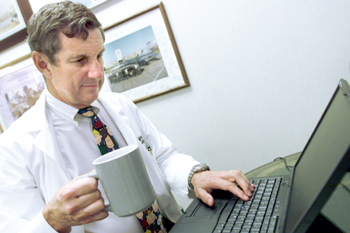
Dr. Drew Gaffney demonstrates the ease of the new system. (photo by Mary Donaldson)
VMG tests outpatient order entry system
Since late June, Vanderbilt Medical Group general cardiologists have been piloting an electronic outpatient order entry system called OPOC, which stands for Outpatient Orders with Compliance.
“The whole point of OPOC is to create an accurate document reflecting the thinking and intention of the physician,” said cardiologist Dr. Drew Gaffney, senior vice chair for Clinical Services with the department of Medicine. “It allows much faster, more accurate completion of information needed for ordering and billing tests and initiating follow-up appointments,” Gaffney said.
The system is one element of e3, a project to eliminate paper-based processes from the clinics by 2003. OPOC will replace technical and professional encounter forms and order forms for lab work and radiology—the system does not include pharmacy orders. Physicians and clinic staff have been involved in designing OPOC from the very first.
The system is already saving cardiologists time in their practice, with no more wading through government regulations to determine if patient documentation is accurate for billing purposes, and no interruptions to clarify orders or information used in billing. “The system will give physicians a new level of assurance that their orders are being communicated correctly and that results will be available when needed,” Gaffney said.
Billing compliance and
other benefits
OPOC helps doctors avoid inadvertently giving away services for free. Government regulations about what constitutes medical necessity are voluminous and constantly changing, and in professional and technical charges, VUMC currently writes off losses of $2.6 million per year because of a lack of documented medical necessity (This doesn’t mean that even one of the services in question was unnecessary, rather, this loss merely confirms that doctors aren’t full-time billing experts.) The loss could be avoided by somehow allowing physicians, in the act of documenting diagnoses and treatment, to bring the Medicare billing regulations into play. OPOC does this for doctors.
The doctor notes diagnoses, selects tests to be ordered, then matches each test with the reason it’s being ordered. (The process is quicker and easier than it sounds, thanks to smart features that anticipate the applicable information.) The system tells the doctor with a simple check mark whether a given reason for a given test constitutes medical necessity in the eyes of the government. If the first inclination about why a patient needs a given test turn out not to be suitable for billing purposes, the doctor has at his or her fingertips complete knowledge about which codes satisfy the government.
When a patient has none of the diagnoses that satisfy the billing requirements, the doctor knows he needs to have a discussion with the patient about paying costs out of pocket and have the patient sign a waiver.
Cardiology has already accomplished various work redesign thanks to opportunities opened up by OPOC. Clinic nurses are pleased to receive daily printouts of orders and follow-up appointments from OPOC, providing a very handy to-do list; patient service coordinators will use OPOC to view orders and physician requests to schedule follow-up visits; clinic techs and coders will also draw information from the system.
An outpatient clinical notes system called Quill is in an early stage of development at Vanderbilt. Work is underway to unite these new systems and existing clinical systems into a single user interface for optimum user ease and efficiency.
The pilot in cardiology is sponsored by Dr. Doug Vaughan, chief of Cardiovascular Medicine, and Dr. Keith Churchwell, assistant clinical professor of Cardiovascular Medicine and director of the Vanderbilt-Page Campbell Heart Institute. Dr. Randy Miller, professor and chair of Biomedical Informatics, is project director for OPOC. Training is provided by Systems Support Services.













